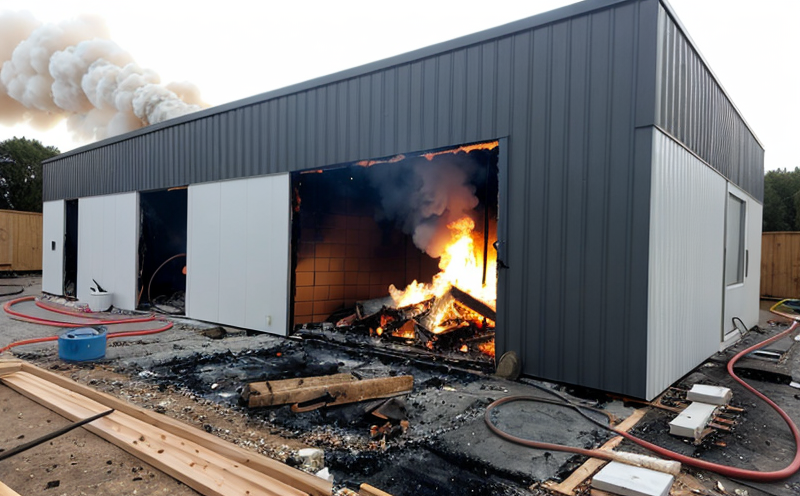ISO 5660-1 Reaction-to-Fire Tests – Heat Release, Smoke Production
The ISO 5660 series of standards provides comprehensive guidelines for assessing the reaction to fire properties of building materials and products. Specifically, ISO 5660-1:2017 is focused on determining the heat release rate (HRR) and smoke production characteristics under controlled laboratory conditions.
The heat release rate is a critical parameter in understanding how much heat is generated when a material combusts. Smoke production, another key metric, indicates the amount of toxic gases released during combustion. Both parameters are essential for evaluating the fire safety performance of insulation materials and cladding systems used in buildings.
In this service, we perform ISO 5660-1 tests on various types of insulation and cladding samples to determine their heat release characteristics and smoke production under standardized conditions. This information is vital for ensuring compliance with local building codes and international standards such as EN 13823 or ASTM E648.
Our testing lab adheres strictly to the prescribed methods in ISO 5660-1, which involves placing a specified amount of test material into a cone calorimeter. The apparatus measures the heat flux through the specimen and quantifies both the total heat released (THR) and the peak heat release rate (PHRR).
Simultaneously, smoke production is measured using an optical particle sizer to quantify the mass concentration of particulates emitted during combustion. This data helps in assessing the potential for smoke obscuration, which can severely impact visibility and exacerbate escape difficulties during a fire.
Our team prepares the test specimens meticulously following ISO 5660-1 guidelines. This includes ensuring that the samples are cut to standard dimensions and weights, with any necessary pre-treatment such as conditioning in a prescribed environment. Once prepared, the samples undergo rigorous testing in our state-of-the-art fire testing facilities.
The results of these tests provide clients with detailed reports on the heat release and smoke production characteristics of their insulation or cladding materials. These data points are critical for making informed decisions about material selection that balance performance, cost-effectiveness, and safety requirements.
Understanding the fire behavior of insulation and cladding is particularly important in high-rise buildings where even minor increases in heat release rates can have significant implications on fire spread and smoke generation. Our ISO 5660-1 testing ensures that clients meet stringent regulatory standards while optimizing material selection for cost-effectiveness.
For industries focused on sustainable building practices, these tests offer insights into the environmental impact of different materials during a fire event. By reducing heat release rates and minimizing smoke production, we contribute to safer, more sustainable construction practices.
Applied Standards
The ISO 5660-1 standard is widely recognized for its rigorous approach to evaluating the reaction-to-fire properties of building materials. This includes not only insulation and cladding but also other construction elements like structural timber, door sets, and curtain walls.
In addition to ISO standards, our laboratory adheres to other international guidelines such as ASTM E648 and EN 13501-1 for supplementary testing where required. These additional tests may be necessary depending on specific client needs or regional regulations.
Our expertise in this domain allows us to provide comprehensive fire safety assessments that go beyond basic compliance with local codes. By aligning our services with these global standards, we ensure that clients receive the most accurate and reliable data possible for their projects.
Scope and Methodology
The scope of ISO 5660-1 includes the determination of heat release rate (HRR) and smoke production characteristics under controlled laboratory conditions. This involves placing a specified amount of test material into a cone calorimeter, which measures the heat flux through the specimen.
During testing, we carefully control environmental factors such as temperature, humidity, and atmospheric pressure to ensure consistent results across multiple samples. The apparatus used for this purpose includes sophisticated instrumentation capable of accurately measuring both HRR and smoke production parameters.
The methodology follows a step-by-step process that begins with specimen preparation. This involves cutting the sample to standard dimensions and weights according to ISO 5660-1 guidelines, followed by any necessary conditioning in a prescribed environment. Once prepared, the specimens undergo rigorous testing in our state-of-the-art fire testing facilities.
The results of these tests provide clients with detailed reports on the heat release and smoke production characteristics of their insulation or cladding materials. These data points are critical for making informed decisions about material selection that balance performance, cost-effectiveness, and safety requirements.
Industry Applications
The results from ISO 5660-1 tests play a crucial role in various industries where fire safety is paramount. In the construction sector, these tests are essential for ensuring compliance with building codes and regulations aimed at reducing fire risks.
In high-rise buildings, even minor increases in heat release rates can have significant implications on fire spread and smoke generation. Our ISO 5660-1 testing ensures that clients meet stringent regulatory standards while optimizing material selection for cost-effectiveness.
For industries focused on sustainable building practices, these tests offer insights into the environmental impact of different materials during a fire event. By reducing heat release rates and minimizing smoke production, we contribute to safer, more sustainable construction practices.
The data provided by our ISO 5660-1 testing is also valuable for insurance companies when assessing risk profiles related to building fires. This information helps them make informed decisions about premium pricing and coverage options.





